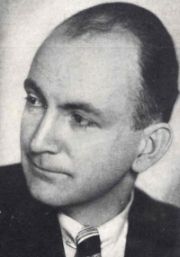Henk Badings
This article includes a list of general references, but it lacks sufficient corresponding inline citations. (February 2013) |

Henk Badings (hĕngk bä'dĭngz) (17 January 1907 – 26 June 1987) was an Indo-Dutch composer.
Early life
Born in Bandung, Java, Dutch East Indies, as the son of Herman Louis Johan Badings, an officer in the Dutch East Indies army, Hendrik Herman Badings[1] became an orphan at an early age. Having returned to the Netherlands, his family tried to dissuade him from studying music, and he enrolled at the Delft Polytechnical Institute (later the Technical University). He worked as a mining engineer and palaeontologist at Delft until 1937, after which he dedicated his life entirely to music. Though largely self-taught, he did receive some advice from Willem Pijper, the doyen of Dutch composers at the time, but their musical views differed widely and after Pijper had attempted to discourage Badings from continuing as a composer, Badings broke off contact.
Music career
In 1930 Badings had his initial big musical success when his first cello concerto (he eventually wrote a second) was performed at the Concertgebouw in Amsterdam. Champions of his work included such eminent conductors as Eduard van Beinum and Willem Mengelberg. He held numerous teaching positions; e.g., at the Musikhochschule Stuttgart and the University of Utrecht. Accused after the Second World War of collaboration with the Nazi occupation forces,in April 5, 1942 he was briefly cancelled from professional musical activity, but by June 3, 1947 he had been reinstated.
Badings used unusual musical scales and harmonies (e.g., the octatonic scale); he also used the harmonic series scale from the eighth to the fifteenth overtone.[2] An exceptionally prolific artist, he had produced over a thousand pieces at the time of his death in Maarheeze in 1987.
Compositions by Badings include fifteen numbered symphonies, at least four string quartets,[3] several concertos, other orchestral works including a "Symphonietta : speelmuziek voor klein symphonie-orkest",[4] other chamber music works, piano works, and incidental music.
In the 21st century, interest in Badings' music has grown. The German label CPO has committed itself to recording Badings' entire orchestral œuvre, and a Badings Festival was held in Rotterdam during October 2007.
Compositions
Orchestral
- Symphony No. 1 (for 16 solo instruments) (1932)
- Symphony No. 2 (1932)
- Symphony No. 3 (1934) (dedicated to Willem Mengelberg)
- Symphony No. 4 (1943)
- Symphony No. 5 (1949) (dedicated to the Concertgebouw)
- Symphony No. 6 Psalmensymphonie (1953)
- Symphonic Scherzo, for orchestra (1953)
- Symphony No. 7 Louisville (1954)
- Symphony No. 8 (1956)
- Symphonic Variations on a South African Theme (1960)
- Symphony No. 9 for string orchestra (1960)
- Symphony No. 10 (1961)
- Symphony No. 11 Sinfonia Giocosa (1964)
- Symphony No. 12 Symphonische Klangfiguren (1964)
- Pittsburgh Concerto for wind and brass (1965)
- Symphony No. 13 for wind instruments (1966)
- Symphony No. 14 Symphonic Triptych (1968)
- Symphonietta for small orchestra (1971)
- Concerto for Orchestra (1982)
- Symphony No. 15 Conflicts and Confluences for symphonic band (1983)
Concertante
- Piano Concerto (1940)
- Double Piano Concerto (1964)
- Violin Concerto No. 2 (1935)
- Violin Concerto No. 3 (1944)
- Violin Concerto No. 4 (1947)
- Double Violin Concerto No. 1 (1954)
- Double Violin Concerto No. 2 (1969)
- Concerto for Violin, Viola and orchestra (1965)
- Concerto for Viola and string orchestra (1965)
- Cello Concerto No. 1 (1930)
- Cello Concerto No. 2 (1939)
- Flute Concerto No. 1 (1956)
- Flute Concerto No. 2 for flute and wind instruments (1963)
- Concerto for Flute, Oboe, Clarinet and orchestra (1981)
- Concerto for Bassoon, Contrabassoon and wind orchestra (1964)
- Saxophone Concerto (1951)
- Concerto for Four Saxophones and Orchestra (1984)
- Concerto for Harp and small orchestra or wind orchestra (1967)
- Organ Concerto No. 1 (1952)
- Organ Concerto No. 2 (1966)
Notes
- ^ See e.g. VIAF authorities for his full name.
- ^ His 4th string quartet uses "31-tone temperament". See its title- OCLC 18059570.
- ^ see e.g. OCLC 19525761; a series of quartets, at least 7, "for instruments ad libitum" - e.g. no.5 here - OCLC 64505265, no.3 here - OCLC 7917325- (this appears to mean, more or less "open instrumentation", the instrumentalists choose the instruments within certain determined boundaries, as was common in the Renaissance/Tudor era - a practice that had a resurgence in the 20th century.)
- ^ which was recorded on LP.
Further reading
- Texts used in vocal music by Henk Badings at The LiederNet Archive
- (in Dutch) A site dedicated to Henk Badings
- Donemus biography (in Dutch)
- Klemme, Paul T. (1993). Henk Badings, 1907-87 : catalog of works. Detroit studies in music bibliography, no. 71. Warren, Mich.: Harmonie Park Press. OCLC 28666144. ISBN 0-89990-065-8 ; ISBN 978-0899900650.
- 1907 births
- 1987 deaths
- 20th-century classical composers
- Ballet composers
- Concert band composers
- Delft University of Technology alumni
- Dutch classical composers
- Dutch male classical composers
- Dutch mining engineers
- Dutch opera composers
- Male opera composers
- Microtonal musicians
- Musicians from West Java
- People from Bandung
- State University of Music and Performing Arts Stuttgart faculty
- 20th-century Dutch engineers
- 20th-century Dutch musicians
- 20th-century Dutch male musicians
- Composers for carillon
- Dutch people of the Dutch East Indies
